| 1 |
Primary serial numbers
on Mosin Nagant rifles, like most European firearms, are on the barrel, rather than the
receiver as in the United States. |
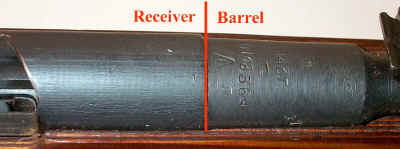 |
| 2 |
Secondary serial numbers
are found in three other locations on the majority of Mosin Nagants.
Bolt |
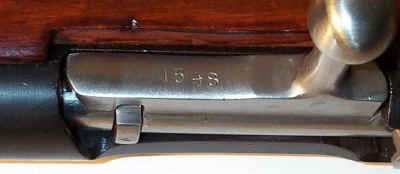 |
| 3 |
Magazine floorplate |
 |
| 4 |
Buttplate |
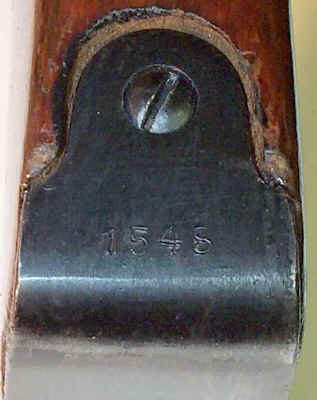 |
| 5 |
Cocking knobs were also numbered
on the earliest Russian production and Remington M91s. Numbered cocking knobs are uncommon
now and it is rare to find one that matches. They are most often encountered on rifles
built in Finland from salvaged parts. |
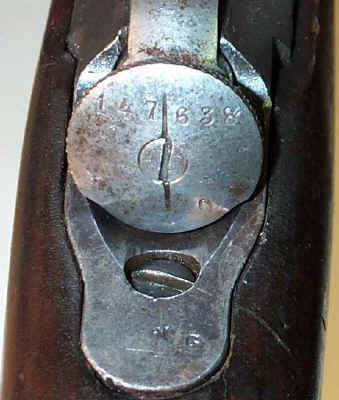 |
| 6 |
Stocks are occasionally numbered. M91s
from the Balkans (seldom matching) |
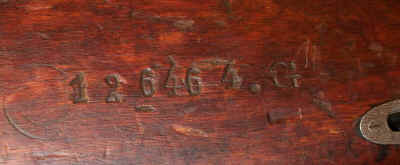 |
| 7 |
Later Soviet production such as M38s, M44s, and M91/59s which
were probably numbered during refurbishment |
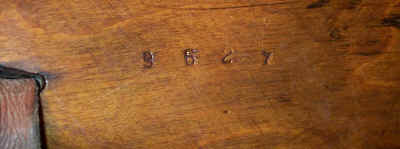 |
| 8 |
Soviet replacement stocks in pencil in the barrel channel |
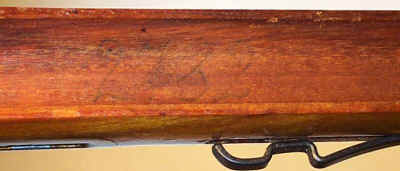 |
| 9 |
Soviet postwar M44 stocks stamped under the buttplate |
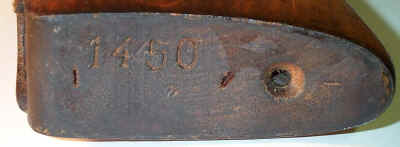 |
| 10 |
Late Chinese T53s instead of the buttplate |
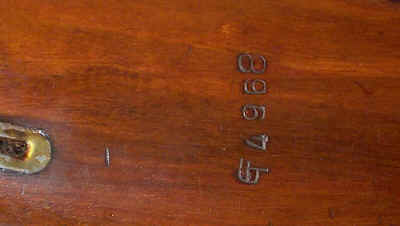 |
| 11 |
Bayonets are also numbered at the
base of the shaft |
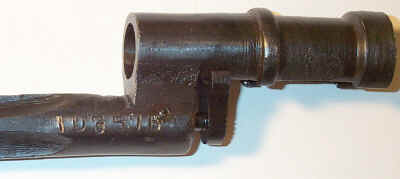 |
| 12 |
Cleaning rods are not typically
numbered but here is a case where one is. It is not matched to the rifle and it is
possible that it is not a serial number, but represents something else. |
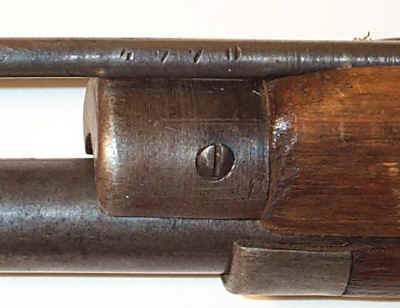 |
| 13 |
Chatellerault prefixed the number
with an "N" which stands for "number" and is not a letter found in the
Cyrillic alphabet. It is technically not a part of the serial number although it is
usually included in the serial number by US importers and FFL holders for record keeping
purposes. Production started at serial number 1 and ran straight through to the end of the
contract. |
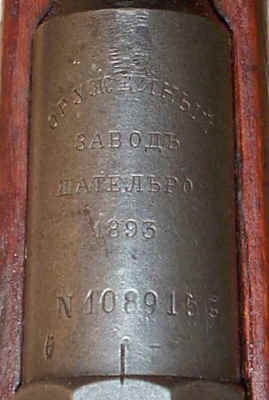 |
| 14 |
Here is a renumbered bolt that has the "N" prefix
on it. Since the "N" was not part of the serial number it is usually not
found on the numbered parts other than the barrel. This was probably done in a
country other than Russia where the meaning of the "N" was not recognized. |
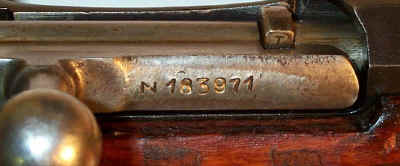 |
| 15 |
Tula used the same "N"
prefix until 1928 when the barrel markings changed. Each year started over at serial
number 1. |
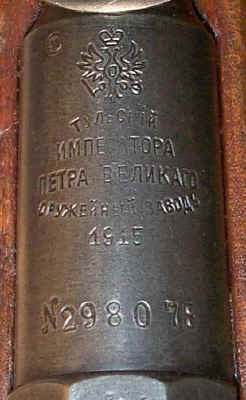 |
| 16 |
Tula began to use "No"
above the serial number when the barrel markings changed in 1928. This also stands for
"number" just as the "N". |
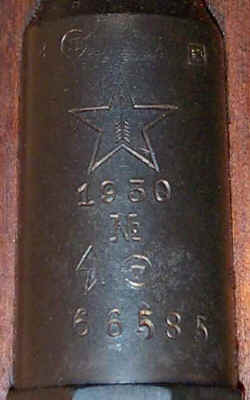 |
| 17 |
Izhevsk did not use the
"N" prefix or the "No" symbol. Each year started over at serial number
1. |
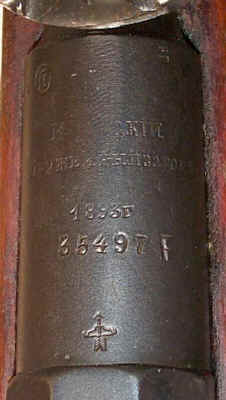 |
| 18 |
Sestroryetsk used "No."
above the serial number, which means "number" just as the "N". Each
year started over at serial number 1. |
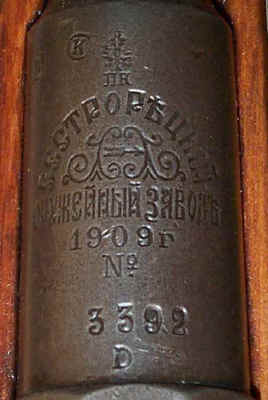 |
| 19 |
New England Westinghouse used
"No." above the serial number, which means "number" just as the
"N". Production started at serial number 1 and ran straight through to the end
of the contract. |
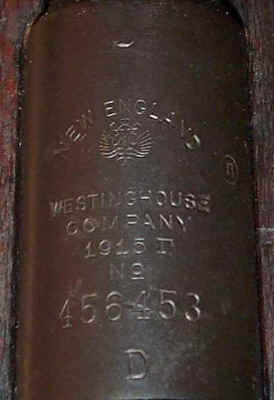 |
| 20 |
Remington used "No."
above the serial number, which means "number" just as the "N". Each
year started over at serial number 1. |
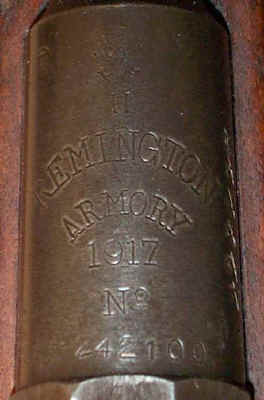 |
| 21 |
Serial numbers repeated at the
Russian/Soviet arsenals and at Remington each year as seen on this rifle and the one
following. 1932 Tula M91/30, serial number 94015. |
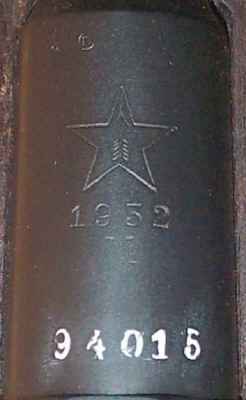 |
| 22 |
1935 Tula M91/30, serial number 94015. |
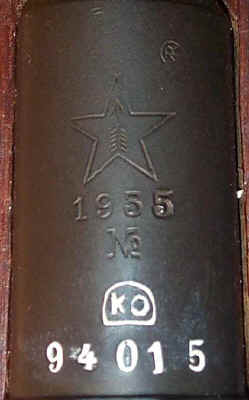 |
| 23 |
Letter suffixes follow some
serial numbers. These are typically found on M91s from the Balkans and are thought to
have been added by other countries. They are not part of the original numbers. Letters
which have been observed are "G" (possibly Turkey). |
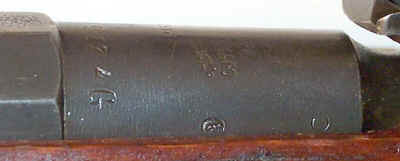 |
| 24 |
"E" |
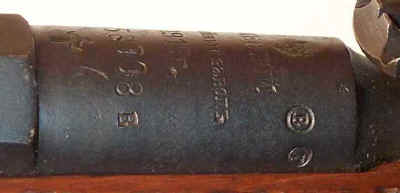 |
| 25 |
"F", most common of the letter suffixes |
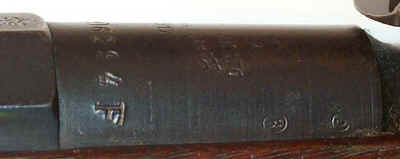 |
| 26 |
"T", very uncommon Picture courtesy of JMKDEVCO. |
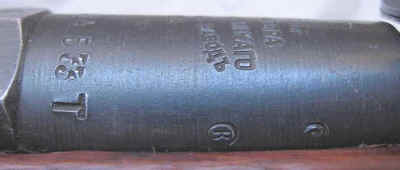 |
| 27 |
Receivers are sometimes numbered
but in most cases it was done by the importer. Russia, the Soviet Union, Eastern European
countries and China almost never numbered the receiver, including rifles produced in
France and the United States. An exception is the earliest Tula production as seen on this
1891 M91. Picture courtesy of Robert Jensen. |
 |
| 28 |
Sure signs that it is an importer number is the use of a
"dot matrix" type stamp, the use of Latin rather than Cyrillic letters on a
Soviet rifle, or the inclusion of other import information along with the number. See the Mosin Nagant Import Marks page for more information. |
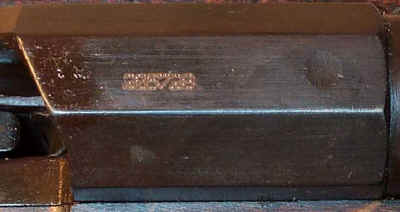 |
| 29 |
Receivers used by Finland were apparently numbered in some
cases. Because of the use of different sizes and fonts of stamps used by Finland and
importers it is difficult to be certain if a Finnish receiver number is original or not.
As with all Mosin Nagants, if it is a dot matrix type stamp it is not original. |
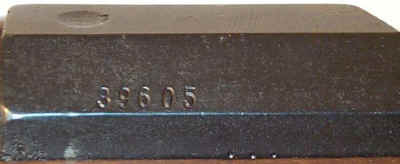 |
| 30 |
Belgian "Blindee" 8mm conversions are an exception
where the serial number is placed on the receiver rather than the barrel. In these cases
the barrel was shortened from the rear for rechambering which removed the original serial
number and did not leave enough barrel shank to easily renumber it there. |
 |
| 31 |
Another exception is this 1931 Izhevsk Dragoon. The
reason for the number on the receiver rather than the barrel is not clear in this case and
is not typical. |
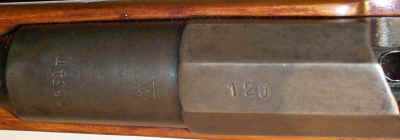 |
| 32 |
Cyrillic "alpha prefixes"
came into use at Tula in 1937. These consist of two letters followed by a number of
four digits or less. The prefixes were apparently assigned at random and changed when
number 9,999 was reached. No known records of the order in which they were assigned
exist. Because of the random use of the Cyrillic characters it is impossible to know
whether a rifle was built early or late in that years production. Also, "low"
serial numbers have no significance because it is not known whether their block was first,
last, or somewhere in the middle of the year. Occasionally a rifle is reported with
a single Cyrillic character, but in all cases it has been found that the second character
was a Cyrillic "Z" which looks like the number "3". Izhevsk began
using this system in 1938. See The Russian Alphabet page
for a list of Cyrillic characters. |
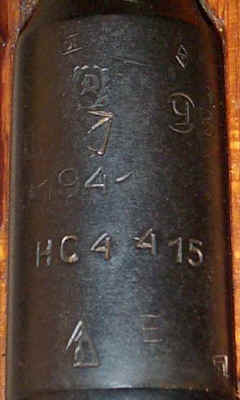 |
| 33 |
The same Cyrillic characters were also stamped on the other
serial numbered parts. Bolt |
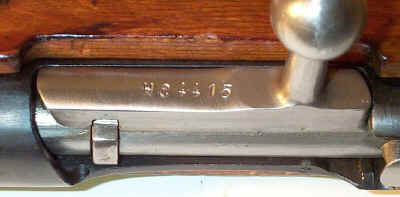 |
| 34 |
Magazine floorplate |
 |
| 35 |
Buttplate |
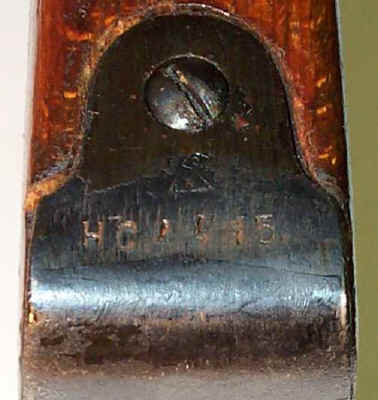 |
| 36 |
Other letters are sometimes
stamped above the alpha prefixes. These are translations of the Cyrillic characters
and were placed there by the importer (Century) to comply with BATF regulations. It
is now a common practice for importers to assign a new serial number to each rifle and the
translations are not required in that case. See the Mosin
Nagant Import Marks page for more information. |
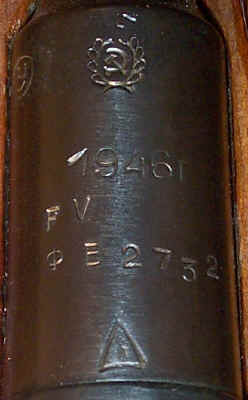 |
| 37 |
Restamped numbers on secondary
parts of refurbished rifles often don't have the alpha prefix. Barrel with original
number |
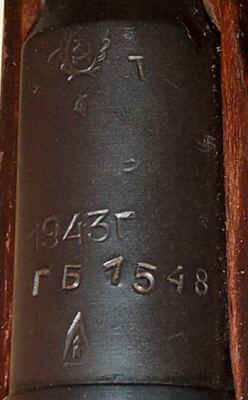 |
| 38 |
Bolt |
 |
| 39 |
Magazine floorplate |
 |
| 40 |
Buttplate |
 |
| 41 |
Electropenciled numbering is
another method of renumbering secondary parts during a refurbishment which was done
freehand rather than with a stamping die. Barrel with original number |
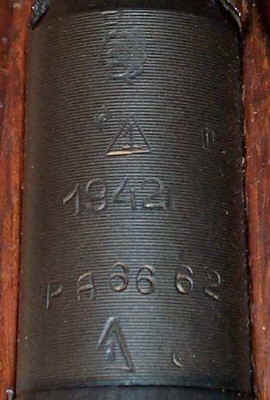 |
| 42 |
Bolt |
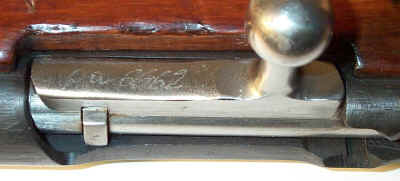 |
| 43 |
Magazine floorplate |
 |
| 44 |
Buttplate |
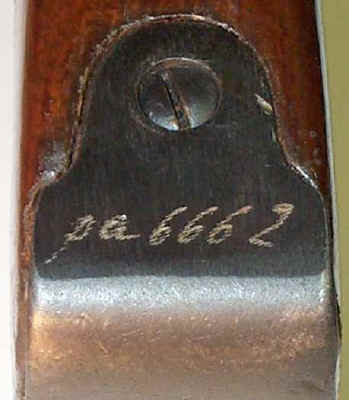 |
| 45 |
Struck through original serial
numbers are sometimes found on secondary parts with the new number added beside it. New
number stamped |
 |
| 46 |
New number electropenciled |
 |
| 47 |
Unconventional serial numbers are
also found on Mosin Nagants. Here is an uncommon case where the original serial number
on the barrel is struck out and a new one added. It is a Czech M91/38 cut down from
an M91. An interesting side note is the "Serbian crown" mark to the right of the
Izhevsk "bow and arrow" arsenal mark. The secondary parts are matched to
the new barrel number.
Barrel |
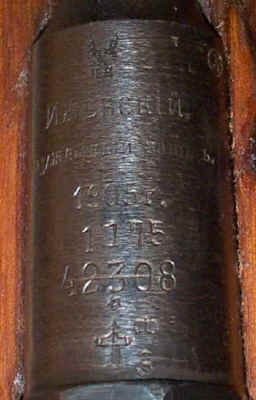 |
| 48 |
Bolt |
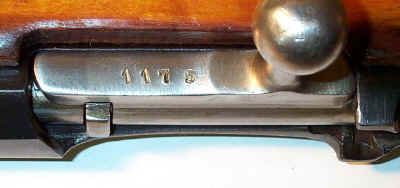 |
| 49 |
Magazine floorplate |
 |
| 50 |
Buttplate |
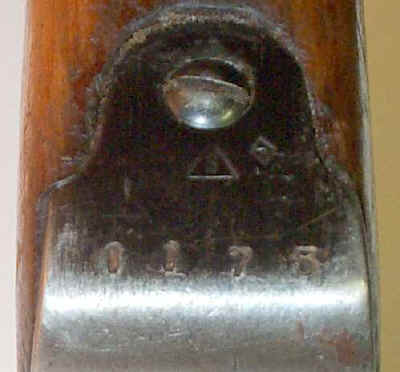 |
| 51 |
This 1897 Finnish marked Dragoon also has it's serial number
lined out and a new one added. The only other number on the rifle is on the bolt body and
it does not match either the original or new numbers on the barrel. Whether the
renumbering was done in Finland or not is a mystery. |
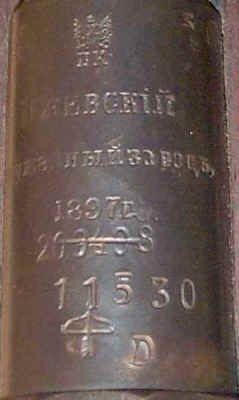 |
| 52 |
This 1940 Tula M91/30 has the original serial number with the
Cyrillic prefix lined out and a new three digit number stamped above it. No other numbers
on the rifle match. Picture courtesy of spoojul. |
|
| 53 |
This M91 has the barrel serial number divided in two parts by
the Izhevsk arsenal mark. It also has the "N" prefix which is not usually
found on Izhevsk rifles. The barrel was probably renumbered in Romania when the date
was changed and the crest of King Ferdinand of Romania added. It is atypical. Picture
courtesy of Josh Norris. |
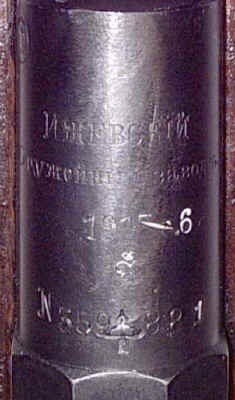 |
| 54 |
This is an Izhevsk M91/30 that has the "No" symbol
before the serial number. It also has an unusual "PM 86" mark whose meaning
is unknown and it's possible it is one of a special series that were numbered outside of
regular production. Another PM 86 M91/30 has been reported numbered 437. Picture
courtesy of rocker98. |
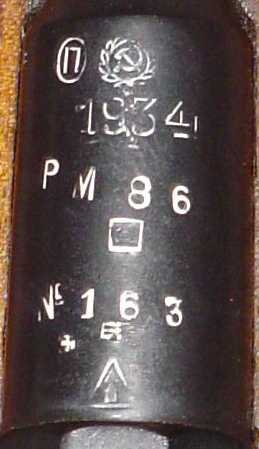 |
| 55 |
This M1907 carbine has no serial number at all on the barrel
however the other parts are numbered. The buttplate and magazine floorplate match
each other and the Remington bolt retains the matching cocking knob, but is not the same
number as the floorplate/buttplate. Picture courtesy of Al. |
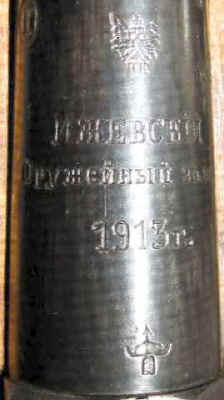 |
| 56 |
This 1939 Tula M91/30 has had the original serial number with
the Cyrillic prefix scrubbed and a new 6 digit number without a prefix stamped in it's
place. The remains of the original number are still partially visible below the new
number. |
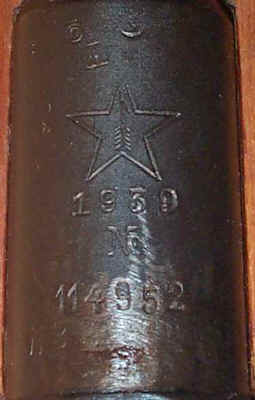 |
| 57 |
This 1944 Tula M91/30 is MO marked and has a 4 digit serial
number without the Cyrillic prefix which was typically used at that time. It is
possible that they unique serial number is related to the MO mark, but that is only
speculation. There is no apparent evidence that another number was scrubbed or
overstamped. |
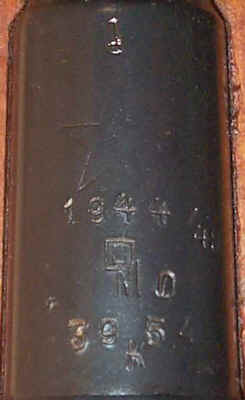 |
| 58 |
This 1943 Tula M91/30 is an ex-PU sniper and similar to the
one above in that it has a 4 digit serial number without the Cyrillic prefix which was
typically used at that time. There is no apparent evidence that another number was
scrubbed or overstamped. |
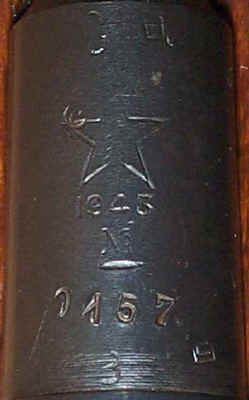 |
| 59 |
Later production Soviet rifles have numbers on the underside
of the barrel and receiver. These don't seem to match each other or the serial
number. They are repeated though with several cases of the same number appearing on
different rifles. It is assumed that these were used for inventory tracking during
production and are not serial numbers. |
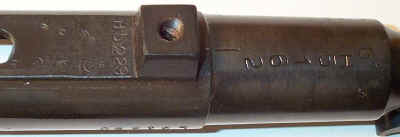 |
| 60 |
Poland followed the Soviet
pattern by using an "alpha prefix", but with Latin letters rather than Cyrillic
along with other differences. The first year of M44 production, 1951, used a single
letter for the prefix and a five digit number beginning with zero for lower
numbers. The numbering of secondary parts also followed the Soviet pattern and
included the bolt, floorplate, and buttplate. Electropenciled or restamped numbers
have not been documented on Polish parts but the sample is small. Picture courtesy of
JMKDEVCO. |
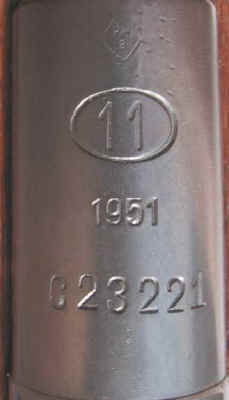 |
| 61 |
In 1952 two characters were used for the prefix and the five
digit number, beginning with zero when required, was retained. |
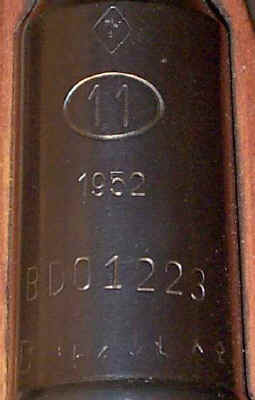 |
| 62 |
In 1955 the two character prefix was retained, but the
numbers were four digit with a zero at the beginning of the number if required. Thanks
to Karl-Heinz Wrobel for information on the changes in the Polish numbering system. |
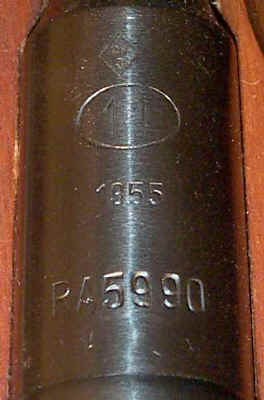 |
| 63 |
Hungary followed the Soviet
pattern of using a two character "alpha prefix", but with Latin letters rather
than Cyrillic, followed by a four digit number. Numbers with less than four digits
haven't been observed but the sample is small and inconclusive. The numbering of
secondary parts also followed the Soviet pattern and included the bolt, floorplate, and
buttplate. Electropenciling has not been documented on Hungarian parts but the sample is
small. |
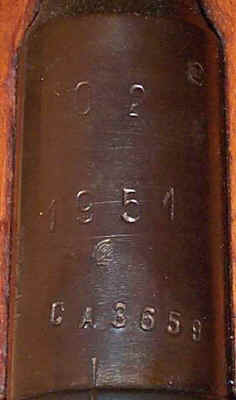 |
| 64 |
Restamped numbers, including the alpha prefix, are
occasionally found on Hungarian rifles with the original number struck through. Magazine
floorplate |
 |
| 65 |
Buttplate |
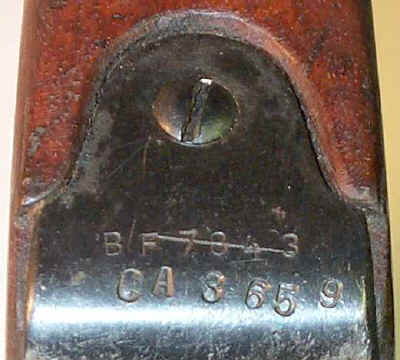 |
| 66 |
Romania followed the Soviet
pattern of using a two character "alpha prefix", but with Latin letters rather
than Cyrillic, followed by a number of four digits or less. Single digit serial
numbers have been observed, but due to the random use of the prefixes these cannot be
considered "low" numbers other than within their prefix block. The
numbering of secondary parts also followed the Soviet pattern and included the bolt,
floorplate, and buttplate. Renumbering of secondary parts by Romania is apparently
uncommon with many rifles simply having mismatched parts with their original numbers left
in place. These parts are often from the Soviet Union, Poland, and Hungary so the
numbers may not follow the Romanian patter exactly. Electropenciling has not been
documented on Romanian parts and restamped numbers are seldom seen. In the few cases
documented the alpha prefixes were not included and the numbers did not match. The
parts could have come from the Soviet Union and not been restamped in Romania. |
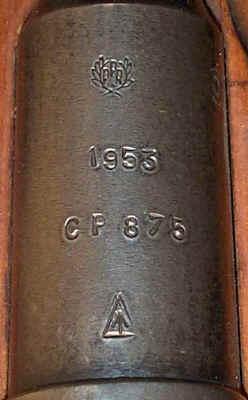 |
| 67 |
China began T53 production in
1953 and the first year serial numbers have an "A" prefix and are followed by
the Chinese character "shi" which means "test" or "trials". |
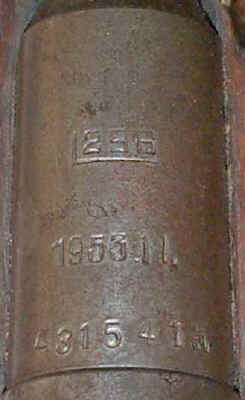 |
| 68 |
In at least some cases only the last digits of the full
serial number were stamped in the secondary locations. Bolt, atypical location |
 |
| 69 |
Magazine floorplate |
 |
| 70 |
With the second year of production (1954) China began to use
a 7 digit serial number. |
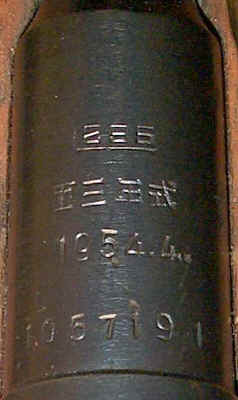 |
| 71 |
The full number was also stamped in the secondary locations. Bolt |
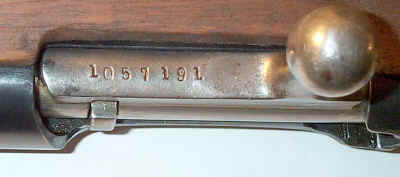 |
| 72 |
Magazine floorplate |
 |
| 73 |
Buttplate |
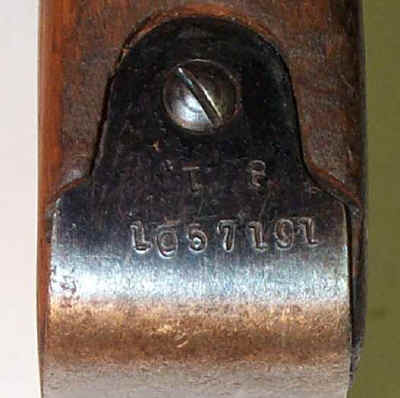 |
| 74 |
During the last year of production (1960) China began to use
a letter prefix and 4 digit number. |
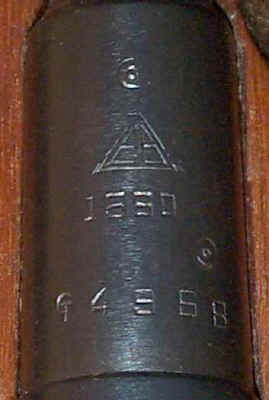 |
| 75 |
The buttplate was no longer numbered in later production but
the stock was. |
 |
| 76 |
Albania made a limited number of
M91/30s and the few that have been documented all have a four digit serial number
beginning with zero. The numbering of secondary parts is typical and includes the
bolt, floorplate, and buttplate. |
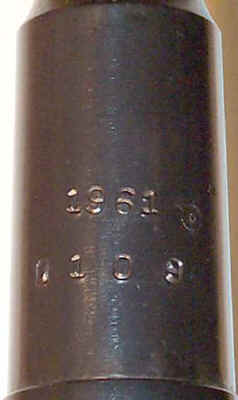 |
| 77 |
Finnish serial numbers do not
typically have letter prefixes or suffixes and can be from 2 digits to 6 digits in length,
some with a zero or zeros for the first digits. |
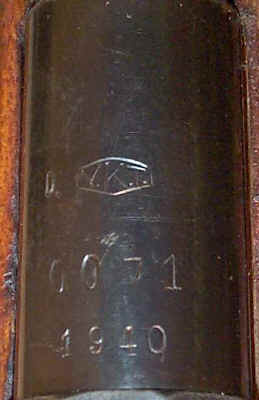 |
| 78 |
Receivers used by Finland were
apparently numbered in some cases. Because of the use of different sizes and fonts of
stamps used by Finland and importers it is difficult to be certain if a Finnish receiver
number is original or not. As with all Mosin Nagants, if it is a dot matrix type
stamp it is not original. |
 |
| 79 |
Secondary serial numbers are
found in the typical locations of the bolt, magazine floorplate, and buttplate. However,
the manner of numbering them is different from the Russian/Soviet rifles and with the
exception of the bolt they are often mismatched. This is not considered detrimental
by most Finnish Mosin Nagant collectors. Finland did not produce bolt bodies and all of
theirs are from purchased or captured rifles. Old serial numbers are often lined out
and new ones stamped beside them, often with only the last four digits. In some cases
several old numbers are present. |
 |
| 80 |
This bolt was scrubbed clean and the new number stamped on
the body. |
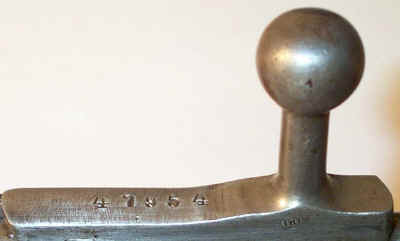 |
| 81 |
This bolt was scrubbed clean and the last four digits of the
new number stamped on the knob. This is common on Finnish rifles. |
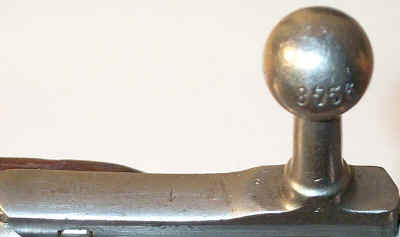 |
| 82 |
This bolt was scrubbed clean and no new number stamped. |
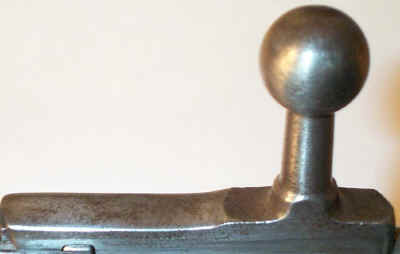 |
| 83 |
This bolt had several old numbers lined out and the last four
digits of the new number stamped on the knob. |
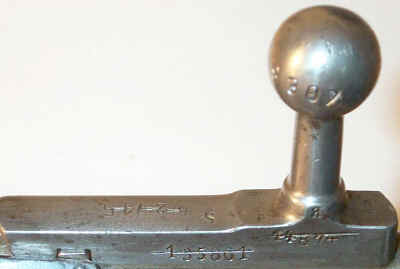 |
| 84 |
This bolt had a new number stamped on the knob which was
later lined out and a new complete number stamped on the body. |
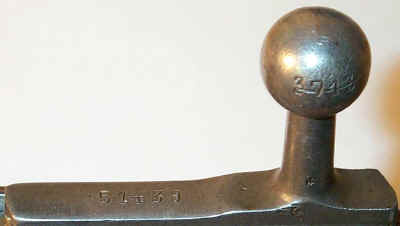 |
| 85 |
This bolt had the complete serial number stamped on the body
which was lined out and the last four digits of the same number stamped on the knob. |
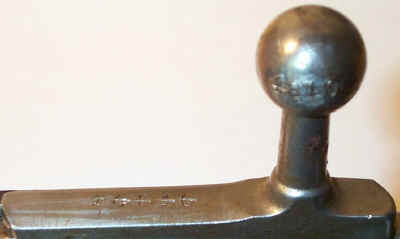 |
| 86 |
In this case only three digits are stamped on the knob rather
than the typical four digits. |
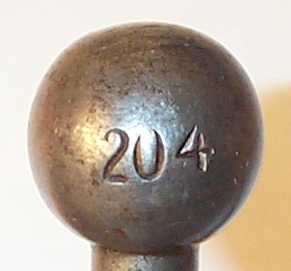 |
| 87 |
Floorplates can be found in several configurations. Scrubbed
clean, common |
 |
| 88 |
Old number left in place, common |
 |
| 89 |
Old number lined out, less common |
 |
| 90 |
Old number scrubbed and last four digits of the new number
stamped, less common |
 |
| 91 |
Buttplates are often scrubbed, but occasionally have an old
number lined out. The last two digits of the serial number were sometimes stamped on
the rear of the plate but many of these are now mismatched. |
|
| 92 |
This is an uncommon case where a bolt head is
numbered to match the rifle. Pictures courtesy of JMK. |
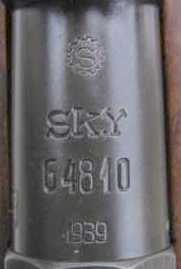 |
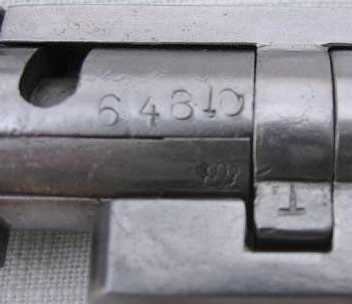 |
| 93 |
Another uncommon case where an M39 nose cap is
numbered on the bayonet lug with the last three digits of the serial number. Pictures
courtesy of Claven2. |
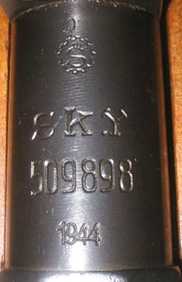 |
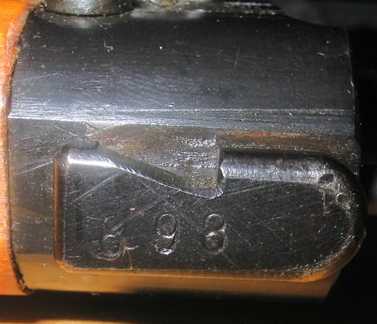 |
| 94 |
M27 winged connector bars were numbered to match with the
last 3 digits. |
 |
| 95 |
Numbers are also found on the underside of the barrel and
receiver. These are not serial numbers but tracking numbers used during production
before the final serial number was assigned. |
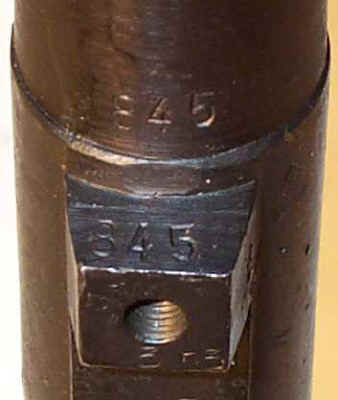 |
| 96 |
Finnish stocks are numbered in some cases, but these are not
the same as the rifle's serial number and should not be expected to match. |
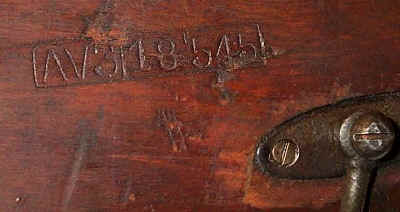 |
| 97 |
Finnish M28/30s and M39s have sight graduations on the side
of the rear sight base that are often mistaken for serial numbers by new Mosin Nagant
collectors. |
 |
| 98 |
Civil Guard rifles also have
District numbers which have an "S" prefix. This lead to some confusion when
the Army took over all stocks of small arms during the Continuation War and it is not
unusual to find a Finnish rifle with more than one serial number. The extra numbers
are often struck out and sometimes the Civil Guard District number is used as the serial
number. This is an M24 with a two digit serial number of 11 which has been struck out.
The Civil Guard district number of S 862 then became the rifles serial number. |
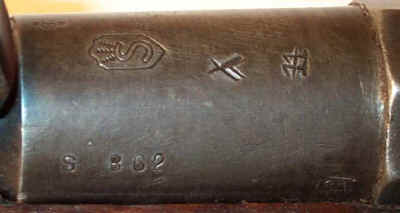 |
| 99 |
The bolt on the above rifle still has the 11 on the body, but
has the knob restamped with 862. |
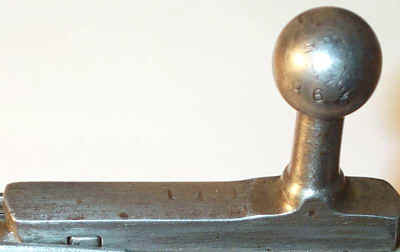 |
| 100 |
An M24 with the Civil Guard District number struck out and
the original serial number left intact. |
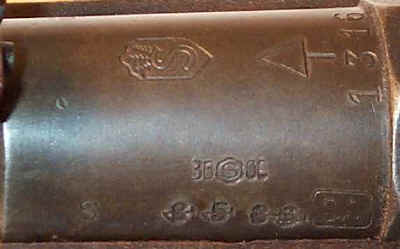 |
| 101 |
An M24 with the serial number on the side of the barrel and a
Civil Guard District number on the receiver which is struck out. |
 |
| 102 |
The opposite side of the above rifle with another Civil Guard
District number on the barrel. |
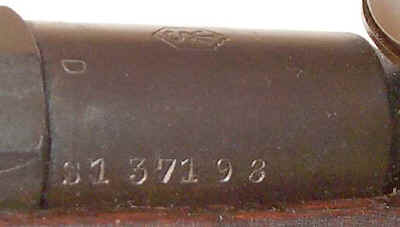 |
| 103 |
A lined out Civil Guard District number with a new District
number stamped above it. On the opposite side of the barrel is the original serial
number which is also lined out. |
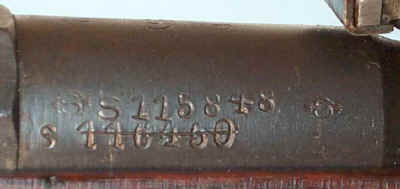 |
| 104 |
An M28 with the serial number lined out. |
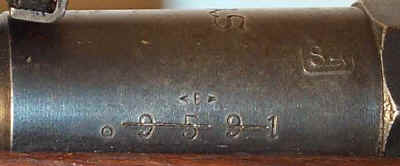 |
| 105 |
The same rifles bolt with the last two digits of the serial
number obliterated on the bolt number. |
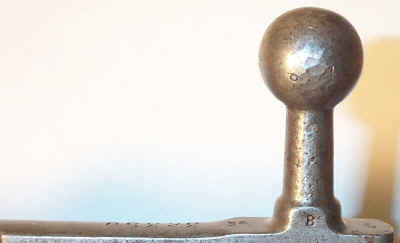 |
| 106 |
The Civil Guard District number on the opposite side of the
barrel of the same M28. |
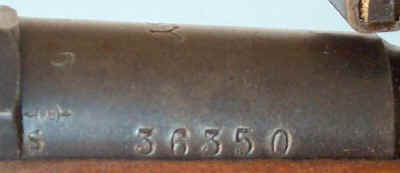 |
| 107 |
The Civil Guard District number complete with the S prefix
stamped on the bolt body. |
 |
















